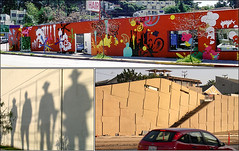Streets as Drive Through Galleries
 Bennett Stein. From today's New York Times.
Bennett Stein. From today's New York Times.In Los Angeles, some designers are turning bare walls -- a ubiquitous feature of the city's streetscape -- into a highlight of the driving experience. A mural made of layers of colored vinyl, top, conceals a parking lot in Silverlake. When Barbara Bestor, an architect, and Paula Norman, a lawyer, remodeled their office building on Fountain Avenue, they extended its 14-foot-high wall to 100 feet in length, and asked the graphics firm Blik, which specializes in in do-it-yourself vinyl pattern kits for interiors, to decorate it.
The shadow of the Wild Bunch on a building on Cahuenga Boulevard in Hollywood, bottom left, was created by Electroland, a local public art team. Cameron McNall, a founder of Electroland, placed cut-outs of iconic movie images on the tops of buildings in Hollywood, to cast shadows on the walls of nearby movie studios. Electroland will introduce another dramatic piece next month on the facade of a new building in downtown Los Angeles: a large-scale display of lights that respond to the movements of visitors in the lobby.
The new retaining wall separating Santa Monica Boulevard from the parallel Little Santa Monica Boulevard in West Los Angeles, bottom right, encompasses a staircase, ramp and bus shelter. Deborah Weintraub, the deputy city engineer for the City of Los Angeles, describes herself as a strong "advocate for bringing design to large, engineered, city projects," and urged the wall's architects, Pleskow + Rael, to make it a compelling feature of the urban landscape. The wall is 1,500 feet long and 30 feet at its highest point. FRANCES ANDERTON



0 Comments:
Post a Comment
<< Home